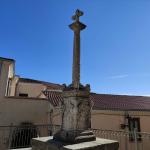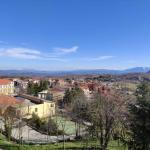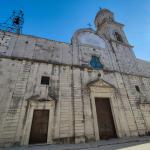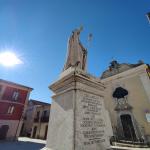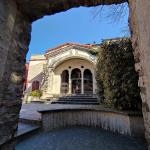The Municipality of Nusco rises in the area of the Calore Valley. It's a village with 4,148 inhabitants, located 914 metres above sea level, at 36 km from Avellino. The territory extends for 53.60 sq km and the adjoining municipalities are: Bagnoli Irpino, Cassano Irpino, Castelfranci, Lioni, Montella, Montemarano, Sant'Angelo dei Lombardi and Torella dei Lombardi. The sources of the Ofanto river flow from its territory.
The etymology of the name of the town seems to be linked to the popular term "musco", used to indicate the moss that abounds in the undergrowth of the village. The inhabitants are called Nuscani and Saint Amatus is their patron saint.
PLACES OF INTEREST
- Co-Cathedral of Sant'Amato (Saint Amatus) - Founded in the 11th century, it has a majestic composite style façade, made up of large boulders of local stone
- Episcopal Palace - Archiepiscopal seminary located in the ancient centre, dated back to the 17th century. It was built at the behest of Bishop Francesco Buonaventura, who had the work begun in 1754
- Diocesan Museum - Exhibition set up in the Episcopal Palace in order to enhance the historical and artistic heritage of the communities belonging to the Archdiocese of Sant'Angelo dei Lombardi-Conza-Nusco-Bisaccia
- Museum of the Treasury Hall of the Cathedral - It preserves sacred objects, silver statues and the remains of the patron saint inside the crypt
- Co-Cathedral of Sant’Antonio (Saint Anthony) - Located on the edge of the medieval castle
- Church bell tower - Building erected in memory of the Bishop of Nusco
- Noble palaces - Natale Palace and Ebreo Palace
- Fontigliano - Naturalistic area located at the foot of the Picentini Mountains, in a natural oasis of vegetation and unspoiled landscape
- Other - Municipal villa, library, Chapel of Our Lady of Mount Carmel, Church of the college of S. Giuseppe (Saint Joseph), Church of the Sacra Famiglia (Holy Family), Church of S. Giovanni Evangelista (Saint John the Evangelist), Church of di S. Maria delle Grazie (Holy Mary of Graces), Church of S. Maria Vetere, Church of S. Rocco (Saint Roch), Church of S. Antonio (Saint Anthony), Church of the SS. Trinità (Holy Trinity), Abbey of S. Maria di Fontigliano
EVENTS
- Bonfires night – Traditional food and wine event, in honour of Saint Anthony with the lighting of large fires in the streets of the village, music, food and wine stands and local crafts
- Che mi salta in menta (What comes to my mint) – Food and wine event dedicated to mint
- Traslazione di Sant’Amato (Transfer of Saint Amatus) – Celebration in honour of the patron saint with procession
- ri li Cicaluccoli festival – Food and wine event with many tastings of the traditional pasta of the territory
TYPICAL FOOD AND PRODUCTS
- Cicaluccoli - Handmade gnocchi served with meat sauce or puzzendu (typical sausage)
- Ricotta di pecora bagnolese PAT - Ricotta of ancient tradition coming from sheep of the “bagnolese o malvizza” breed, constantly grazing
- Ricotta manteca di Montella PAT - With a cylindrical form and stray yellow colour, it has a soft, delicate and buttery texture: a very good food due its organoleptic characteristics
- Caciocavallo podolico dei Monti Picentini PAT - Tasty and rare cheese aged up to 6 months, raw, hard and spun curd, particularly valuable
- Caciocavallo Silano PDO - Semi-hard cheese, with spun curd, produced with milk from different breeds of cows, including Podolica
FUN FACTS
The town of Nusco is part of the prestigious "I Borghi più belli d'Italia"(Italy's Most Beautiful Villages) circuit and is called "Balcony of Irpinia", as it is among the highest in the province, and from the village you can admire a splendid panorama.
HISTORICAL NOTES
The first evidence of the history of Nusco date back to the will of the bishop Amatus, who, in 1093, described his bishopric with the word civitas. However, the origins of the Castle may date back to some centuries earlier, at the time of the secession of the Principality of Salerno from the Duchy of Benevento, which took place in 847.
Many families have governed these territories: among these the D’Aquino, Del Balzo, Caracciolo and Carafa families. The last feudal lords of Nusco were the Imperiale, until the abolition of feudalism in 1806.
Many of the homes of these families, still perfectly preserved today, are surrounded by elegant gardens and can be visited, having kept their original structure intact.
Nusco is fire, a deep, intense and introspective experience, to be lived not only through eyes
Nusco
Via San Giovanni, 2, 83051 Nusco AV, Italia
Events
A secular feast linked to Saint Anthony, that takes place on the 17th of January of every year…
-
From 19 to 21 January 2024, in the ancient heart of the wonderful Irpinia village, the event…
The second evening on the occasion of the 11th edition of the Goleto festival on July 15, 2024
Featured places
Piazza Vescovado, 13, 83051 Nusco AV, Italia
Dedicated to the patron saint, it has a notable artistic legacy. The recent discovery in the…
Piazza Vescovado, 3, 83051 Nusco AV, Italia
The archiepiscopal seminary located in the historic town centre dates back to the 17th century…
Piazza Vescovado, 3, 83051 Nusco AV, Italia
An exhibition of sacred art set up inside the Episcopal Palace, it aims to tell the stories of…
Did you like it? Leave a review
Your opinion is important! It will be visible after approval by the editorial staff.
To post a comment you must be an authenticated user. Log in with Social Login
